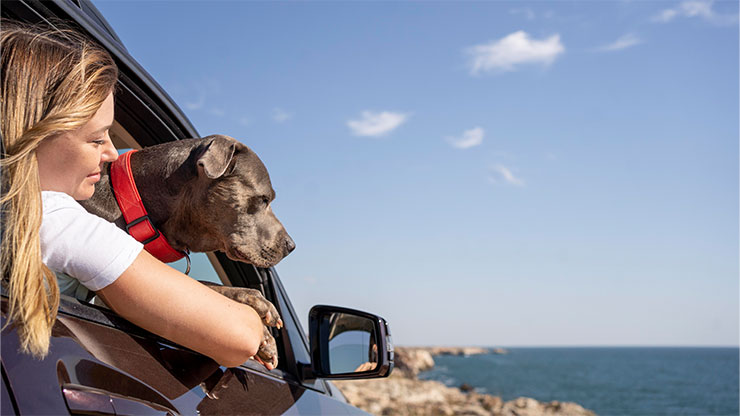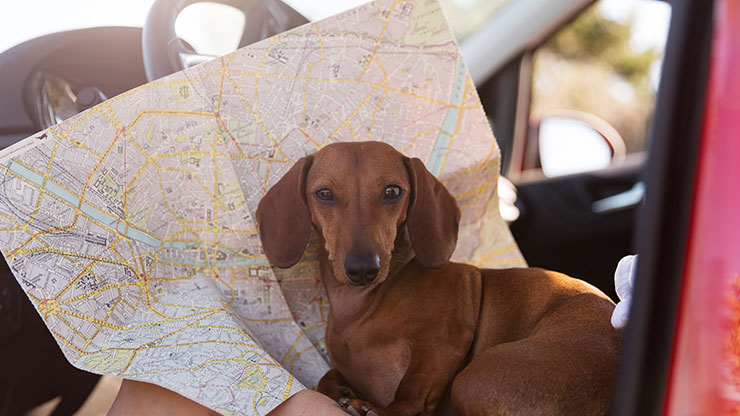
Tips For Training Your Dog To Be a Good Travel Companion
If you’re considering traveling with your dog, you must ensure they have all the training they need for a smooth and successful trip. Let’s take a closer look at how you can train your dog to be a good travel companion.
Obedience Training
Obedience training is one of the most basic types of training, so this is a great place to start. When traveling, you’ll want to ensure your dog is familiar and confident with basic commands like “come,” “stay,” “wait,” “heel,” and “lie down.” If you have other basic commands you use in everyday life, like “leave it,” feel free to add them to the list of commands to review before your trip.
Traveling will also introduce your dog to many new environments, so practicing these commands in different locations with various levels of distraction can help increase focus and reliability.
Do’s for Successful Training
Positive reinforcement is man’s second best friend when it comes to training. Giving your dog a reward like food, attention, or praise when they follow commands correctly will yield far more success than punishment, which can lead to confusion and fear.
Practicing consistency and patience is essential, especially if you’re training a new dog or puppy. Try to keep training sessions under ten minutes long, and if you notice your dog getting distracted or less engaged, wrap up the training on a positive note with a command they already know, along with lots of praise and treats.
Things To Avoid When Training
Avoid grabbing your dog when reinforcing commands, even if they’ve followed a command correctly. This can confuse your pup, so offer praise, treats, attention, or a toy instead.
Leash Training
Whether you’re taking a road trip or flying overseas to another country, you’ll be doing lots of walking. Here’s how to leash train your dog for your trip. Start by making sure your dog is comfortable with their leash or harness. Some dogs take longer to warm up to their leash than others, so have patience and start slow. Let your dog wear their leash inside to get used to it before taking them for a walk on it. Be generous with treats during the beginning stages so your dog associates their leash positively.

Heel Training
Once comfortable with their leash, your dog is ready for heel training. Heel training teaches your dog to stay by your side when walking. Traditionally, dogs heel on the left side, but whichever side you choose, just be consistent. In the same way, some owners prefer the commands “let’s go” or “follow.” Whichever command you use, just be consistent. Starting inside the house is an excellent way to introduce heel training to your dog without the distraction of unknown territory. Once they’ve shown progress inside, you can increase your pace, walk side to side, and try new places.
General Leash Training Tips
One of the most important leash and heel training tips is to hold your treat or prize close to your chest. If you hold the treat by your side or in front of your dog, they can learn to follow the food rather than the heel.
If your dog pulls, leaves your side, or misbehaves on their leash, refrain from pulling or yelling. This can negatively impact your progress thus far. Instead, stop walking, call your dog back, and offer a treat when they return to you. Similarly, if your dog lunges at other people or animals while on their leash, try to redirect your dog’s attention and offer a treat when they return to you.
It’s also important to communicate when your dog does a good job. Most owners use words like “yes” and “good job” or use a clicker to communicate a job well done. The same tips for obedience training also apply to leash training, so be sure to have patience and consistency and to keep training short.
Socialization Training
Socialization is essential for supporting your dog’s confidence and introducing them to new people, animals, places, and stimuli without fear. While traveling, you’ll encounter other people, animals, and other foreign objects along the way. Investing in socialization training for your dog is essential to a smooth and enriching trip.
Socializing with Other Dogs
Dog parks, playgroups, going on walks, and going on playdates with other dogs are excellent ways to teach your furry friend how to behave around other dogs. Start slowly to avoid overwhelming your dog with too much change at once. You can start by introducing your dog to one new dog at a time until they feel comfortable around new dogs.
Socializing with People
Continually handle various parts of your dog’s body so they get accustomed to people touching them. If your dog becomes suddenly stiff, shows the whites of their eyes, closes their mouth, or attempts to escape, stop handling them.
Introduce your dog to new people frequently to promote comfort around strangers and friends. Positively reinforce encounters with strangers or new people. If your dog shows any signs of aggression or anxiety, remove them from the situation.
Things To Look For
Your dog may display aggression or anxiety when socializing. It’s critical to learn what signs to look for to keep your dog and others safe. Aggression in dogs typically stems from fear, so if your dog becomes aggressive with other people or animals, it’s likely from fear. Abrupt changes can be scary for our furry friends. Instead of punishing fear, which can lead to further confusion and misbehavior, redirect your dog’s attention or remove them from the environment.
Aggression can manifest in many ways, but here are the most common signs of fear aggression to look for:
- Sudden rigidness
- Growling, snarling, or deep barking
- Lunging at other people or animals
- Baring their teeth
- Snapping or biting
If you notice consistent signs of aggression in your dog, consider working with a canine behavior expert or your veterinarian. In addition to aggression, watch for anxiety in your dog while helping them socialize. Signs of fear and anxiety include aggression, destructive behavior, excessive barking, pacing or restlessness, drooling, and excessive panting.

Socialization Safety Tips
In addition to teaching your dog appropriate behavior around other dogs and people, it’s also important for your dog to know how to be alone. Your dog may like to follow your every move when you're home. Too much time with your dog can lead to separation anxiety when you’re not home. Learn to implement boundaries and create healthy periods of alone time for you and your dog.
Introducing New Environments
Abrupt changes can be stressful for dogs, especially regarding their environment. Luckily, with the proper training, you can prepare your dog for new environments and enjoy new places together.
Start Slow
Incorporate new environments slowly. Start by showing your dog a new room or area of a home they’re already familiar with. Then, introduce them to the car. Take them to a friend’s house or an empty park or field before taking them to a busy, often overstimulating dog park. When introducing your dog to new places, do so with short sessions and consistency.
Once your pup builds confidence with new environments, consider taking them to the lobby of a nearby hotel. This can help them get familiar with the hustle and bustle environment of hotel lodging. It’s also essential to ensure the hotels you book on your trip allow pets. Use Romingo to find the best pet-friendly hotels for your adventure.
Attention Shifting With Positive Reinforcement
Use positive reinforcement to shift your dog's attention from other animals or people to you. This will help your dog learn to focus on you in new environments. It’s also important that you demonstrate calm when showing your dog a new place. Being too excited can lead to an overexcited dog.
Watch For Signs of Distress or Anxiety
Always watch for signs of distress or anxiety in your dog. If you notice any of the signs previously mentioned, remove your dog from the situation and end the training session with a command they already know and lots of positive reinforcement.
Happy Traveling
It can take a lot of time and patience before your dog is ready to take a trip. But with consistency and these training tips, you’ll soon be able to enjoy traveling with your furry best friend.










